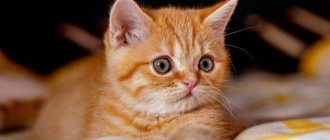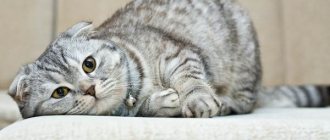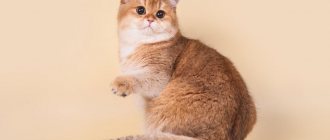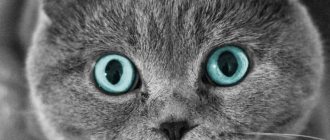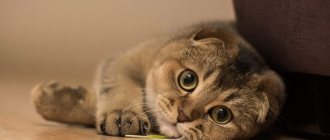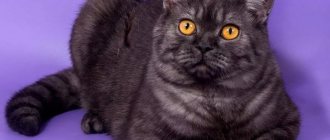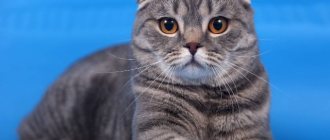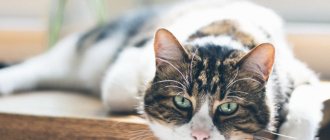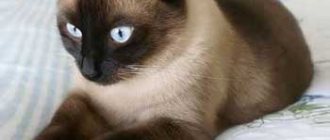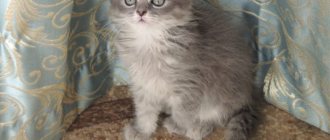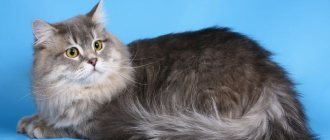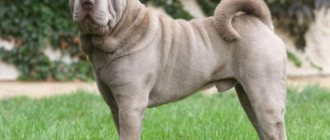The Scottish cat is an extremely popular breed. Its representatives live on average 15 years. There are some individuals that live up to 20 years or more. Thus, on average, the life expectancy of Scottish fold and straight-eared cats and cats is approximately the same as that of other breeds.
But this only concerns the question of how long Scottish cats and fold-eared and straight-eared cats live at home. Such a tailed animal will live much less on the street, and here's why. At home, the food is better, the care is better, the veterinarian is available when needed, affection and care are all around.
Article continues after advertisement
Another significant factor is the birth of kittens. Sterile cats have a much longer life expectancy, this has been proven by scientists. Animals that are not neutered live shorter lives on average. But, if a cat periodically gives birth to kittens at home, this happens with better nutrition and medical care, and she does not do this as often as in nature, then she also has a good chance of living a long time. In street conditions, cats give birth 3-4 times a year, which depletes the body, and as a result, including this, life expectancy is only 5-7 years. This is normal, because otherwise we would have had an overpopulation of cats on our planet long ago.
How many years Scottish Fold cats (Scottish Folds and Highland Folds) live also depends on the presence or absence of musculoskeletal diseases. The thing is that fold-eared cats are predisposed to joint diseases, which can sometimes result in a serious problem. The culprit is the lop ear gene, which deforms the cartilage. Straights don't have this problem.
But let's not talk about the bad. Let's assume that you have chosen a healthy kitten, keep it in good conditions, groom it and cherish it in every possible way. Under such conditions, the life expectancy of Scottish fold cats can easily reach 20 years. To bring it closer to this mark, you need the following:
- choose the right breeder, buy a healthy kitten, preferably a girl, because... females live about 2 years longer than males;
- get all vaccinations on time, but only with high-quality vaccines;
- when a cat appears in the house, eliminate all dangers that may threaten its health;
- sterilize (castrate);
- do not let him go outside on his own;
- feed raw natural food according to a balanced menu or purchase the highest class food;
- take him to the veterinarian for examination on time;
- often play with the cat so that he has good physical activity;
- choose only high-quality and safe care items and toys;
- truly love your pet.
Subject to these conditions, you get the maximum chance that you will live happily ever after with your cat.
How long do cats usually live?
Representatives of small cats in the wild live relatively short lives - 5-6 years . The lifespan of stray cats is approximately the same. Reasons for this:
- poor diet;
- irregular meals;
- invasive diseases;
- infections;
- lack of protection from predators;
- stress associated with the struggle for survival;
- harsh climatic and weather conditions.
The shortest lifespan—4 years—is for cats that, by chance, end up on the street. After a comfortable stay at home, they do not adapt well to the new environment. The fate of neutered cats is even sadder: being unable to compete for a place in the hierarchy, they immediately become outcasts from the pack and do not live more than three years. A little more time—approximately 3.5 years—is given to cats whose bodies are exhausted by constant pregnancies, childbirth, and nursing offspring.
Cats with loving owners have a different fate and life expectancy. Care and attention, human patronage, and the opportunity to receive veterinary care allow them to live 15 years or more.
This is interesting! The oldest cat whose age was confirmed by documents, and not by the words of the owner, was a cat from Devon (Great Britain). She lived 34 years and 5 months.
The absolute champion in survival is the cat Lucy. At the time the record was entered into the Guinness Book (2011), according to the owners, she was 39 years old.
Return to content
Appearance care.
It is necessary to create the necessary conditions for the life of a fold-eared cat:
- buy inventory;
- engage in education;
- feeding.
But caring for a purebred animal does not end there. Without taking care of the appearance, keeping a cat will not be complete.
Bathing
Despite the belief that cats, whether straight or fold, do not like to swim, many pets quickly get used to water procedures. It is important to ensure that the water is warm and does not get into the baby’s ears.
Breeders advise washing the Scottish Fold 3-4 times a year and whenever it gets dirty: if the animal has been walking and gets dirty. Pets performing at exhibitions are bathed immediately before the event. Use a specialized shampoo. Dry shampoo is used as a replacement for water procedures.
Nail trimming
From a young age, pets are taught to trim their claws.
Adult cats get used to the procedure and behave calmly. It is better for babies to cut their nails immediately after sleep: the baby will not worry and disturb the owner. Procedure:
- Firmly but carefully fix the kitten in your arms.
- Press on the pad of the paw.
- The baby stretches out its claws, and then the visible part is cut off without touching the skin.
Scissors are purchased in specialized departments and pet stores.
Grooming
The pet's fur is treated with a metal comb. It is necessary to comb the baby once a week, and during the molting period every day.
How long do Scottish Folds live?
The calling card of the breed, the charming fold of the Scottish Fold, arose due to spontaneous mutation and was secured by gene recombination during the selection process. The gene responsible for the anatomical changes in the Scottish auricle also affects the process of formation of all other cartilaginous tissues. Kittens homozygous for this gene have serious defects:
- limited mobility of the joints of the limbs and vertebral joints (osteochondrodysplasia, osteoarthritis);
- skeletal deformities;
- dysfunction of the spinal cord.
Individuals with such anomalies often die before reaching sexual maturity. Another genetically inherited disorder of Scottish Folds is susceptibility to the disease hypertrophic cardiomyopathy. This cardiac pathology quite often causes the sudden death of an animal, regardless of its age.
Scottish fold cats that do not have congenital diseases or anomalies that threaten their health or life, with proper maintenance and care, live on average about 15 years.
Return to content
Caring for your ears
Your pet's closed ears look very cute. But due to their shape, they are susceptible to contamination and bacterial growth. The pet cannot clean them on its own. Pathogenic bacteria can cause enormous harm to a cat's health. Therefore, the ears must be clean. In addition, ticks love to get into floppy ears. If you take your cat to the country and it regularly walks, be sure to check the animal for ticks. If you find an insect, it is better to contact a veterinarian rather than treat it yourself.
What affects life expectancy
The main factors that determine a cat's lifespan include:
- heredity;
- conditions of detention;
- quality of diet;
- characteristics inherent in a particular breed;
- availability of veterinary care;
- features of the permanent habitat.
In addition, sterilized pets live several years longer than their counterparts who have preserved their reproductive organs: surgical intervention eliminates the possibility of infection through contact with an infected partner, as well as the development of diseases of the genitourinary system in older cats.
This is interesting! It is believed that outbred cats or those born from mixed marriages live longer and are healthier than their pedigree counterparts, who often pass on genetically determined diseases to their offspring.
The so-called free range, and in fact - unsupervised stay on the street, increases the risk of death of a domestic cat from the aggression of other animals, various injuries, accidents, and dangerous infectious diseases. The life expectancy of a free-roaming cat is much shorter than that of a indoor pet.
Return to content
What to feed?
There are several food options for Scottish Straights.
- Ready meals. Today, stores offer a large number of options for ready-made mixtures. Manufacturers create menus for pets based on all the substances and vitamins they need. However, it is worth noting that in addition, some manufacturers may add addictive substances. If a pet eats such food for a long time, then over time it will no longer eat anything but it.
- Homemade food. It consists of preparing individual dishes for your pet with your own hands. This is the best option for kittens. However, it requires a lot of free time.
- Combined menu. Involves a mixture of store-bought and homemade food.
The choice of food type depends on three factors:
- the time that owners can devote to cooking;
- pet health;
- what the animal is used to eating.
Let's take a closer look at how each type of nutrition differs.
To create a natural menu, you will need to study the literature on what vitamins your little friend needs. Typically, a natural menu includes steamed or raw vegetables, fish, eggs, dairy products, poultry, offal, cereals and porridges. Since cats are still predators, the basis of their diet should be meat and protein (it is necessary to strengthen the skeleton).
Ready-made food can be divided into dry and wet (food in bags). And according to quality they are divided:
- for premium feed;
- super-premium class;
- economy class.
Since Scots are very sensitive to the composition of food, economy class food is not suitable for them. They can be used once, for a variety of nutrition.
To maintain your pet’s body, it is necessary to supplement its diet with vitamin complexes. They are sold in veterinary clinics or pharmacies. There are vitamin complexes created specifically for the Scottish breed. In this matter, there is no difference between the fold-eared and straight-eared representatives of the breed. In addition, it is worth growing special cat grass on the windowsill. The seeds of this herb are sold in pet stores. This will allow the animal to always receive fresh vitamins. You should not feed your pet grass grown outside, as there may be parasite larvae on the stems.
Special attention should be paid to drinking water. The pet should always have access to it
You can pour water into a bowl or a special drinking bowl. Many pets prefer to drink tap water. Representatives of the Scottish Straight breed are also noted for their love of cold tea.
How to increase the lifespan of a Scotsman
Thanks to many advances in veterinary medicine and the development of the pet business, the lives of pets have become much longer and more comfortable . To ensure that 15 years is not the limit for the life expectancy of a Scottish Fold, its owner must be responsible, starting with the choice of a kitten and throughout the pet’s life.
- You should only purchase a fold-eared baby from a conscientious, reputable breeder or at a cat show. This solution minimizes the risk of purchasing a sick animal.
- Particular attention should be paid to issues of maintenance and care.
- Even before the furry newcomer appears in the house, you need to decide on the type of food he will eat, whether it will be factory-made food or natural products. When choosing ready-made food, preference is usually given to the “super-premium” and “holistic” classes: these lines take into account the age, breed and individual characteristics of cats.
- A natural diet should be balanced, varied, meeting the needs of carnivores in general and Scottish Folds in particular: contain not only all nutrients, but also taurine, which Scottish cats, like all other cats, do not produce on their own.
Important! The process of digestion and fermentation of food in a cat’s gastrointestinal tract depends on the type of food. Mixing canned and natural products in one serving is unacceptable, as it leads to disorders of the pancreas and intestines.
- Routine and preventive examinations by a veterinarian are required, as well as timely vaccinations against rabies, panleukopenia, chlamydia, calcevirosis, and rhinotracheitis.
- Given the propensity of the Scottish population for cardiomyopathy and the difficulty in diagnosing this disease, ultrasound of the heart and chest should be included in the examination.
- Monitoring the condition of the gums and teeth must be constant: dental problems lead to diseases of the digestive system.
- If breeding a breed is not the purpose of purchasing an animal, it is advisable to sterilize it in due time.
- Regardless of whether the Scottish Fold is outdoors or in contact with other animals, periodic anti-parasitic measures are required.
- To maintain muscle tone and good shape, your pet needs to be provided with physical activity through games and training.
Such careful care and sincere love will allow the Scottish Fold to live to the respectable age of twenty.
Return to content
Proper nutrition and diet
A balanced diet is the key to health. Consult with a specialist to choose the right food for your cat. Good food contains all the necessary vitamins and you do not have to purchase additional vitamins. The food can treat some diseases common to cats of this breed. Don't experiment with Scotch's diet. After all, it directly affects the health of the pet. It is preferable to feed cats with high-quality food. Under no circumstances should natural food be mixed with feed. This is stressful for any cat's digestive system.
Interesting information about the representatives of the breed
Highland fold (Scottish fold longhair cat)
Scottish cats have not only an unusual appearance, but also a special behavior. They can often stand on their hind legs for a long time, which they do not to attract attention to themselves, but to stretch their spine. Fold-eared pets are also afraid of heights, so they do not climb onto cabinets and curtains.
Some representatives of the breed sometimes have erect ears, so they are confused with another Scottish Straight breed. This can lead to unpleasant consequences, as inexperienced owners often mix straight-eared folds with straights, and sick mixed-breed kittens are born.
Active lifestyle
From the first days of being at home, the baby is playful and cheerful. Up to a year old, the cubs actively use various toys, then the animal matures and becomes calmer
Scottish Straight and Fold pets are most often not prone to depression. But it is important not to let the animal lie for a long time. A sedentary lifestyle will lead to weight gain for your pet, and extra pounds are considered an additional burden on the cat’s internal organs.
- Cat accessories for a carefree active life:
- artificial mouse; with a rattle on the tail or radio control;
- labyrinth; tunnel;
- bed (panoramic bed for animals);
- house - a transformer or a house with various balls and balls;
- cat hammock;
- arch scratcher: the animal passes under the arch and at the same time scratches its back;
- rustling balls;
- laser pen: pet runs after the ray;
An active pet will be able to remain healthy and cheerful for a long time. A decline in activity is observed during pregnancy and illness of the cat.
A child’s lack of desire to play with his favorite objects can be a sign of illness.
To answer the question of how long Scottish cats live, you need to study the advice of experienced owners of purebred animals and the recommendations of breeders. If you have information, it is easier to find the right ways to create conditions for the development of pets. Caring for a Scottish cat, proper nutrition, attention, education and love for your pet will help increase the quality and life of your mustachioed pupil.
Exterior Features
Those who want to know how long British cats live at home would do well to familiarize themselves with the breed standard. These are medium or large, broad-boned, squat animals with well-developed muscles. A distinctive feature of these individuals is their beautiful plush fur. On the large round head are widely set, slightly rounded ears. The color of the eyes depends on the shade of the fur.
The standard provides several possible coat tones. Representatives of this breed can have tortoiseshell, bright red, lilac, black, white, chocolate, cream and blue-gray fur. A characteristic feature of the British is considered to be a muscular body with a wide back, turning into a thick, tapering tail.
Those who want to understand how long a British cat lives will be interested in how these animals behave. Let us immediately note that the luxurious handsome men have a rather friendly disposition. But, despite their easy-going nature, they have their own opinions.
During the first meeting, this aristocrat can give the impression of an extremely unfriendly creature. But once she understands who she has to deal with, she will become more sociable. In addition, representatives of this breed are very freedom-loving and will not tolerate inconvenience. They will never lie next to their owner against their will. The British are very active and playful. Even at an advanced age, they will not refuse to run after the ball.
Appearance
British Fold is a Scottish breed of cat.
Scottish Folds have a fairly well-fed and powerful body. Cats come in different colors, the most popular being gray fur. The color of cats is divided into two groups: plain and patterned.
Patterned marbled color
Solid colors of fur are classified as monochromatic: white, black, gray, blue, red, chocolate, lilac.
The patterned colors include the following:
- spotted, round or oval-shaped spots on the back, sides and tail;
- marble, patterns in the form of a ring and a half ring;
- colorful, small spots and dots on the limbs and head, which are much darker and more contrasting against the background of the main color of the fur;
- chinchilla, a small part of the hairs is colored white or black, for example, completely blue cats may have white hairs on the abdomen or limbs.
Dimensions and weight of fold cats
Scottish cats are usually medium in size, but their bodies are stocky and muscular. The average weight of cats is about 4-7 kilograms, and cats are much heavier, ranging from 7 to 10 kg.
Ears
The ears are set wide on the head, “hanging” towards the bottom, but turned forward. They are small in size and rounded at the ends.
Eyes and nose
Large folded eyes with a perfect round shape. They are quite wide open, which gives the impression that the cat looks surprised.
The short nose is wide and straight. The animal has an excellent sense of smell, which makes British cats one of the best hunters among domestic cat breeds.
Torso and limbs
The chest, shoulders and back are wide compared to the rest of the body, the neck is short. The hind legs are short but muscular. The tail is also short and rounded at the tip.
Head
The cat's wide and massive head is shaped like a circle, and its chin is firm. The cheeks of a pet are wide and plump, in addition, the whisker pads are also round. The mustache is long and clearly defined.
British Folds love to stand on their hind legs.
Detrimental environmental factors
Scottish cats were bred as a decorative breed; they are not adapted to life on the street. Cats do not tolerate temperature changes well. The danger for them is drafts, which can cause colds.
Scottish Folds have a delicate nervous system. They do not tolerate stressful situations well. Fear and anxiety should not be present in a cat's life. At the same time, representatives of the cat family need personal space and freedom.
Participation in the process of reproduction is important for all animals. But statistics show that spayed and neutered male cats live, on average, several years longer.
An important factor is heredity. You can study your pet's pedigree. If a cat’s ancestors lived a life close to 20 years, then he has every chance of reaching this milestone.
History of the breed
The history of the discovery of the Scottish Fold breed is very interesting. In the early 1960s, a man named William Ross was walking in a place called Angus, in Scotland. There, on one of the farms, he met an unusual cat, whose ears were folded down, which gave the impression that the animal’s head had a regular round shape. The man persuaded the pet's owner to sell the animal, and Scottish Fold cats became known outside not only Scotland, but also the mainland.
Scottish fold cat
In 1978, the breed was presented at the World Pet Show in the USA. In 1993, the Scottish Fold was officially registered.
Standards
The weight of a Scottish Straight individual is 3-3.5 kg, rarely more.
| Standard | Description |
| Head | The shape of the skull is round, with convex cheeks and forehead. The cheekbones are clearly defined (more so in cats than in cats), the chin is strong. The whisker pads are oval and plump. The nose is short, with a wide bridge and no noticeable stop. |
| Eyes | Large, widely spaced. The iris can be any color. |
| Ears | Large, wide at the base and with rounded tips. The outside is abundantly pubescent, the inside is less, but lush panicles, hard and long, grow on the skin. |
| Torso | Muscular, long, large, but with soft smooth lines. The neck is muscular and short. |
| Limbs | Long, strong, with oval and elastic legs. |
| Tail | Long, dense, reaching the shoulder blades in length. |
| Wool | The coat is thick, dense, and plush to the touch. It can be either short or medium length. Undercoat is present. |
Serious defects are considered:
- turned out toes;
- cryptorchidism;
- creases on the tail;
- short tail;
- small eyes;
- explicit “stop”;
- flat forehead;
- too wide ears.
